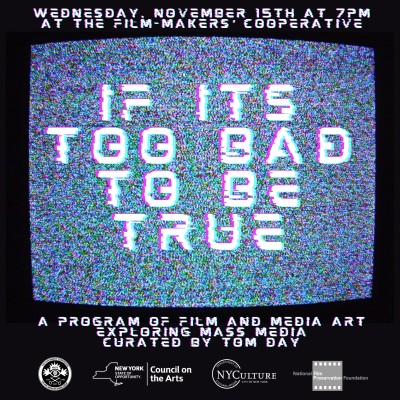Screening

On Wednesday, November 15th, at 7pm, join us at the FMC Screening Room (475 Park Avenue South, 6th Floor) for an engaging program of film and media art exploring mass media, curated by the FMC's Executive Director, Tom Day.
In an age of permanent crisis, perpetual war and consistent political upheaval, one constant has continued to filter and re-present our world: televisual mass media. Despite our own age of cord-cutting, piracy, catch-up services and streaming-on-demand, television news and advertising has remained remarkably robust and engaged with by millions of spectators (a fact bolstered by the coronavirus lockdowns). As long as the world has been mediated by corporate entities and powerful institutions, such authorities have been met by astute, satirical, and oftentimes cerebral analysis by film and video artists. In this selection of work, we explore the stakes and claims of the mass media as filtered through the prism of rigorous, poetic, and comedic artistic lenses.
Anchoring and opening the program will be a rare public screening of Malcolm Le Grice's early expanded cinema piece Castle 1 (1966). Taking inspiration in part from Franz Kafka’ titular novel and Marshal McLuhan writings on media, Le Grice repurposed footage found in the trash of SoHo postproduction houses, collaging the random excerpts into a dense, affective amalgamation that reminds viewers of the basic effect media to alter our capacity for seeing, hearing, and sensing the world. Following this installation work we will turn to a set of video works produced at the height of the Reagan era and at the dawn of cable-based 24-hour news television. Martha Rosler’s iconic work of media critique If its Too Bad to be True it Could be DISINFORMATION (1985) décollages and renders an NBC Nightly Newscast almost illegible, transforming a report on the calamitous proxy wars then occurring in Central America into a series of disjointed soundbites. Jason Simons’ coldly analytical and acerbically humorous Production Notes: Fast Food For Thought (1987) pairs real television spot advertisements with their original production notes in which advertising agencies cynically instruct production companies on how ads should look, sound, and feel to market to an increasingly atomized and corporatized public sphere. Following this pair of direct interventions, we turn to a mercurial and dynamic exploration of fear-mongering, substance abuse and TV addiction as parsed through the dream logic and sensory overload of a day and night-long TV-binge in Mary Filippo’s Feel The Fear (1990). We conclude the session with a rare outing for Omar Fast’s rigorously composed, unsettling montage of two years’ worth of CNN anchors broadcasting. CNN Concatenated (2002) rearranges words spoken by the journalists that have been isolated and meticulously recombined to narrate a disturbing, dense, and narratively ambiguous account of being a media spectator at the dawn of the new millennium. Created in the shadow of 9/11 and its immediate fallout, Fast’s video remains one of the most accurate bridges between a media age of multichannel cable and satellite television and the remix-laden, multi-tabbed attention economy of our own post-internet times.
***
PROGRAM:
- Malcom Le Grice (British, b. 1940) – Castle 1, 1966. 16mm, black and white, sound, 17 minutes. bulb, cable, winker.
- Martha Rosler (American, b. 1943) – If its Too Bad to be True it Could be DISINFORMATION, 1985. Video, color, sound, 17 minutes.
- Jason Simon (American, b. 1961) – Production Notes: Fast Food for Thought, 1987. Video, color, sound, 28 minutes.
- Mary Filippo (American) – Feel The Fear, 1990. 16mm, black and white, sound, 22 minutes.
- Omar Fast (Israeli-American, b. 1972) – CNN Concatenated, 2002. Video, Color, sound, 18 minutes.
Total Run Time c. 100 minutes.